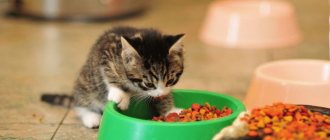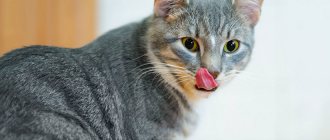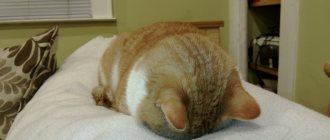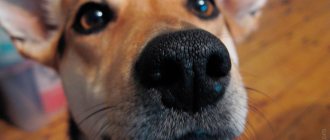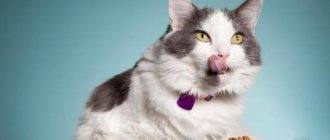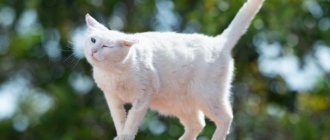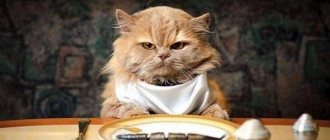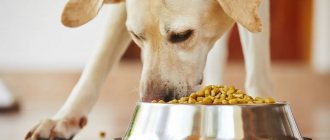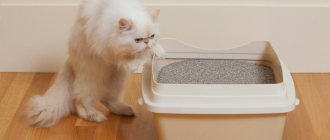The kitten is stressed
New kitten owners often struggle with giving up dry food. They bring the baby into the house, having thoroughly prepared and provided the new family member with everything necessary, including high-quality dry food. As a rule, their first desire is to feed the pet, and the disappointment and even anxiety of the owners is quite understandable when it encounters the kitten’s complete indifference to food.
No need to rush! Let the baby get used to the new place, explore the territory, get used to the fact that he was left without his mother, brothers and sisters. Before offering him food, it is better to play with the baby, this will calm him down and allow him to work up an appetite.
What to feed the baby?
It is impossible to immediately say what to feed a kitten in this or that case, without considering the accompanying circumstances. We would strongly advise switching purebred babies to dry food only when they are at least eight months old . Ideally, this is done closer to a year. This requirement is connected with the whimsical nature of the organisms of such animals.
On the contrary, outbred and physically strong kittens are not so sensitive to the quality of feeding. So the final choice is always up to the owner. It is also advisable to consult a veterinarian.
Dry food is a new food for a kitten
If your pet was not accustomed to dry food before coming into your home, then, of course, at first he will look at the new food with suspicion. Therefore, he needs to be introduced to it gradually, first by gradually mixing it with the food to which the baby is accustomed, and every day increasing the share of dry food in the total volume.
Soaking the granules in warm water can also help with habituation. Once slightly soaked, they will acquire a softer texture, and the kitten will be more accustomed to such food. You can read more about how to properly soak kitten food here.
Rules for switching to new food
When changing your usual diet, you need to be patient and consistent. You should not scold an animal or indulge it when it presses for pity. A sharp transition is harmful to health, so the new food needs to be mixed a little with the old one. On average, this takes 1-2 weeks.
Frequent product changes are harmful!
Frequently changing brands is fraught with problems with the gastrointestinal tract. To avoid diarrhea and constipation, veterinarians recommend sticking to a specific brand even on a therapeutic diet. This is not so difficult, since most manufacturers produce several lines that take into account the age and other characteristics of the animal.
Transition from straight
It's not safe to mix different types of foods, so don't be surprised by temporary bowel problems. In this case, this cannot be avoided, so be patient and adhere to the following scheme:
- 25% “drying” and 75% natural – 1-4 days;
- 50% of each type – 5-9 days;
- 75% “drying” and 25% natural – 9-14 days.
At the end of 2 weeks, pellets should make up 100% of the diet. For the first 4 days, you can soak them a little in water so that your pet is not scared off by the unusual consistency.
Switching from wet food
Feeding only wet canned food softens the gums, causing increased bleeding and premature tooth loss. For this reason, they should be combined with dry granules.
The principle of transition here is similar to the previous point. The only difference is that the final proportion must correspond to the instructions on the food packaging. There are detailed rules for feeding animals with 2 types of food.
Please note that increasing the amount of dry kibble will require a large amount of liquid to digest it. Make sure your pet drinks enough water and replace it with fresh water regularly.
Kitten doesn't like dry food
This happens if the ready-made industrial diet is not complete enough for a small predator. Animals determine the composition of food by smell, and the most significant for them is the aroma of meat or fish, as well as the corresponding fats. If a kitten does not feel these components in food, then it will refuse it for a very understandable reason: such food is not suitable for it.
Therefore, when choosing dry food, pay attention, first of all, to the number of meat components in its composition; they should form the entire basis of the diet, that is, occupy at least the first five places in the list of ingredients. You can get a complete picture of what dry cat food should be like from this article.
Food quality as a cause of decreased appetite in cats
Sometimes it happens that a cat’s appetite worsens due to a change in the quality of food. The cat feels well, does not show symptoms of the disease or they have been excluded by the veterinarian, but the appetite is still reduced; the pet eats, but as if with reluctance, perhaps even asks for other food. In this case, you need to pay attention to the food that the cat eats.
First, check the expiration dates on the packaging and make sure that the food is not expired. Also analyze the storage conditions - if they are violated, the food may lose its taste and even deteriorate. It must be stored in a cool place, without access to light and air, in a tightly closed container so that it does not erode.
Re-read the ingredients on the food package and try to determine if it has changed. You can use the manufacturer’s websites or online pet stores to compare the information on them with the composition on the packaging. It happens that the manufacturer changes the formula of the food, adds new ingredients to the composition or excludes something from it, reduces or increases the amount of any ingredient - cats can react to such innovations, including with a decreased appetite.
It is also important to check the organoleptic properties of the food (smell, taste, color, shape of granules). If they are not the same as the product in the previous pack or are very different, contact the store where you made the purchase, the manufacturer or distributor and try to negotiate an exchange of food or a refund.
If your cat does not eat dry food well, you can try giving it soaked: pour a small amount of food into a bowl, add a little water to it, let it sit for a while (10-15 minutes) and offer it to the cat. Not all cats agree to eat dry food in this modified form, but there are some who like it. When feeding soaked dry food, the main thing is to follow safety rules: pour in as much food as the cat will eat at a time, and do not leave it in the bowl for a long time - in hot weather, bacteria will begin to multiply in it within half an hour, and such food will become dangerous to the cat's health.
If a cat does not eat wet food well, the algorithm of actions is the same as in the case of dry food: we check expiration dates, storage conditions, organoleptic properties, changes in composition. All these factors need to be analyzed and understood what could be the reason for the deterioration of appetite. Manufacturers usually have many different flavors in their wet food lines; you can offer your cat wet food with a different flavor and watch her appetite. But do not overdo it, so as not to develop pickiness in your pet.
To make wet food more attractive to your cat, you can warm it up to 35-40 degrees (but no more) and see if the cat's reaction to warm food changes. It is also extremely important not to leave canned food in the bowl for a long time: put in as much as the animal can eat in one meal, so that the food in the bowl does not dry out and so that pathogenic bacteria do not multiply in it.
The kitten is naughty
All family members want to pamper the baby, and this desire is quite understandable, but food is not the best, and in any case, not the healthiest way to show your affection. Communication and games are much more important to a kitten, but additional treats can only lead to overeating, although the dry food in the bowl will remain untouched.
Constant chaotic treats also have another danger - the kitten may begin to systematically “extort” tasty treats from each family member in turn, and they, out of the kindness of their hearts, will feed the pet everything that it does not ask for. This situation does not lead to anything good - from digestive disorders to the appearance of excess weight.
Do not follow the kitten’s lead, feed in accordance with the recommended norm, and if the baby is naughty, do not give him anything other than dry food, and warn all family members about this. As a rule, after a few hours of the fast, the appetite returns.
Backup options
It is important to open the briquette with food right in front of the cat. Most animals will be attracted to this and will gobble up the food with interest. There is another interesting method - feeding the cat from your finger. The fact is that many cats will never touch the food in the bowl. They will lick this same food off their finger with great pleasure.
Let’s assume that the animal simply didn’t taste the food. But finger feeding will help you quickly get used to the food in his bowl. It is even possible to slightly open his mouth so that he can quickly feel the taste of food. If the kitten does not eat dry food, you now know what to do.
The kitten is sick
You should really worry only when the kitten refuses any food, not just dry food. As a rule, loss of appetite is accompanied by other symptoms - lethargy, discharge from the nose and eyes, upset bowel movements, vomiting, and fever. In this case, you should definitely consult a doctor.
The most common reasons why a kitten does not want to eat dry food are the whims of the pet and the inappropriate composition of the product. Take these moments seriously, learn to understand dry food and start developing the right eating habits in your baby - then you won’t have any problems feeding your kitten.
Reasons why a cat may stop eating dry food
There are many factors that can cause a cat to refuse dry food. They are divided into physiological and pathological. Pathological factors are diseases, intoxications, infectious lesions, inflammatory processes in the digestive tract, damage to the central nervous system, and helminthiasis.
If a cat shows interest in the food, sniffs it, but at the last moment begins to turn away, the cause could be a neoplasm in the gastrointestinal tract, inflammation, or the presence of a foreign object.
Digestive tract problems do not exclusively affect the intestines and stomach. Pathological changes may affect the mucous membranes of the oral cavity. Dental diseases cause discomfort to the pet when eating dry food, while interest in softened food and pates remains. In an attempt to get rid of discomfort and pain, the cat may begin to chew hard objects.
The cause of discomfort and pain in the oral cavity when eating can be neoplasms. When injured by solid foods, the tumors not only cause pain, but also begin to bleed. You can diagnose tumors in a cat’s mouth yourself with a detailed examination.
Problems with bone and muscle structures can provoke refusal of food and loss of appetite. The animal is limping and in pain. In some cases, there is a violation of the processes of regulation of acts of feces and urination. It is necessary to seek help from a veterinary clinic as soon as possible. a qualified specialist will conduct all the necessary research to identify the cause of the violations.
A cat’s refusal to eat dry food can also be caused by the following pathological conditions:
- Poisoning. Intoxication of the body, provoked by internal processes or the penetration of poison from the environment, is accompanied not only by the cat’s refusal to eat, but also by an increase in heart rate, attacks of nausea and eruption of gastric contents. Serious intoxication is often accompanied by an increase in body temperature. Severe cases of poisoning are characterized by the loss of the ability of animals to navigate normally in space. Lack of timely assistance leads to a gradual failure of the body’s internal systems and the death of the cat.
- Lipidosis. A serious pathology, a characteristic feature of which is excessive accumulation of fat cells in the area of the liver structures. The pet gradually loses its appetite, up to a complete refusal of food. Exhaustion develops due to refusal of food, the costal bones and bone structures of the sternum begin to bulge. Symptoms of lipidosis, as well as other pathologies in the hepatobiliary system, are problems with digestion, icterus of visible mucous membranes.
- Internal organ injuries. Damage to the digestive tract is characterized by severe pain, swelling, and decreased blood pressure. Blood is often found in cats' stool, which indicates hidden internal hemorrhage.
- Infectious diseases. A cat’s refusal to eat accompanies almost all disturbances in the functioning of the body. Infectious lesions of the genitourinary system can also manifest themselves in the form of refusal of dry food. The reason for refusing to feed is systemic intoxication of the body with decay products of pathogenic bacterial microorganisms that provoke inflammation. Without timely help, the acute form of inflammation often becomes chronic.
- Problems in the functioning of the brain and spinal cord. The cause of disturbances in the functioning of the central nervous system is often mechanical damage. The animal refuses food due to disturbances in signal transmission along nerve fibers. The cat stops receiving signals of hunger, although during this period the body needs useful nutrients and energy.
- Helminth infestation. Cats that frequently receive pieces of raw meat as treats, as well as those that come into contact with stray animals, are at risk of contracting helminthiases. It is important to follow the rules of regular antiparasitic treatments to avoid serious complications due to infection with worms. Mild forms of infestation in the body are characterized by a deterioration in general well-being and the appearance of large amounts of mucus and blood in the feces. Severe cases of helminthiasis are manifested by blockage of the intestinal lumen.
- Intestinal obstruction. A cat’s refusal to eat dry food is also associated with a blockage in the movement of food through the intestines as a result of blockage. The animal not only refuses to eat, but also suffers from severe pain. Abdominal bloating, attacks of nausea and vomiting occur. Without timely, qualified help, a pet can die in the shortest possible time. Treatment usually involves surgery.
In some cases, an animal that refuses to eat suffers from disturbances in its sense of smell and vision. Food that is unattractive to a cat, especially in the form of dry granules, should be replaced with something more attractive.
Owners are advised to dilute dry kibble with a special pate or use most wet food. Naturally fed cats should receive slightly warmed food, as its palatability increases.
In addition to pathological reasons for a cat’s refusal to eat dry food, there are also physiological factors. These include:
- Eating dry food for the first time. It is considered normal for a cat to react when she tries dry food for the first time; proceed with caution. The animal is repelled by the texture and smell of new food. If your pet has previously eaten other dry food or natural food, it is recommended to gradually switch to a new type of food.
- Not quality food. Dry food has a long shelf life - from 2 to 3 years, but only under the right storage conditions and in sealed packaging. If the packaging has already been opened, the shelf life is rapidly reduced. Most dry food granules contain oils that go rancid and oxidize quite quickly when exposed to air. The food may deteriorate as early as 3 weeks of use. Giving such food to animals is prohibited. Otherwise, the risks of intoxication of the body cannot be excluded.
- Spoiled. Cats are quite cunning and inventive. In order to get what they want, they can use different methods, including capriciousness. A cat that refuses dry food often receives a treat from its compassionate owner to maintain its strength. In the future, this leads to the formation of a stable habit - not to eat your own food, but to beg for delicacies. It is extremely difficult to wean your pet from such behavior.
- Getting used to various flavor enhancers. Most foods belonging to the economy class group are enriched with various flavor enhancers. When trying to switch to more expensive and high-quality food, the owner may encounter the problem of refusing food. This is due to other taste preferences. The transfer from one type of food to another must be done gradually, not in 1-3 days, but at least 7-10 days.
- Stressful conditions. Loss of appetite and temporary refusal of food occurs in cats during severe emotional shock. A stressed animal is unable to eat.
- The period of sexual hunting. The beginning of the period of sexual hunting, especially in males, is marked by the refusal of food, even the most beloved. Feeling physical discomfort under the influence of instincts, the animal focuses on a single goal - reproduction. It is useless to try to change this phenomenon until the period of sexual hunting is over. For owners of cats and female cats who do not plan to receive future offspring from their pets, doctors recommend undergoing a planned surgical intervention - castration.
Some owners of domestic cats notice that sometimes the animal refuses food for the whole day, and then begins to eat as if nothing had happened. This is due to the natural instinct of cleansing or a fasting day.
Cats intuitively feel that the body needs rest, especially the digestive tract, so they may not eat for 1-2 days, while constantly drinking water. In the absence of additional symptoms - anxiety, pain, discharge, apathy in the animal - there is no reason to worry.
Health problems
A kitten’s refusal to feed often happens for reasons related to the health and well-being of the animal. Here are the most common ones.
- Poisoning.
Cats are by nature very curious creatures, what can we say about little kittens who want to taste everything in sight? It is quite possible that some bad product will come across and cause poisoning in a small cat. In this case, the cat will refuse any product. You should not force-feed him; it is better to take him to a veterinary clinic and show him to a specialist. He will select treatment methods and prescribe rehabilitation therapy. - Disease of the gums or teeth.
A cat may well get stomatitis. Then the food granules will begin to cause pain to the animal, and it will begin to refuse this food. - Helminthiasis.
A kitten, especially if it likes to walk outside, can very easily pick up worms or some other parasites. The owner can visually determine their presence, but it is better to contact a specialist who will conduct an examination and prescribe treatment.
Unsuitable cookware
Cats are very clean animals, so they can be capricious when it comes to food if the “dining room” does not meet their requirements. Your pet may refuse food if:
- Food is served from a plastic bowl. As you know, plastic has a very unpleasant chemical smell, clearly distinguishable by the delicate animal sense of smell. In addition, plastic can react chemically with food ingredients. In connection with the above, it is recommended to buy metal or porcelain bowls for pets.
- The plate is poorly washed or contains dried remnants of the previous dinner. Animal hygiene rules should not be blatantly ignored.
- Cat dishes are washed using household chemicals, which leave a lasting scent trail. Immediately after eating, it is enough to rinse the bowl under running warm water.
- The food bowl is placed in an inappropriate place, such as close to a tray of sand or running water. Cats instinctively separate the “dining room” and the “toilet”, taking care of the cleanliness of food and water.
- The food container is excessively narrow and deep, and therefore has an unpleasant effect on the cat’s whiskers. It has been proven that the whiskers of animals perform the function of touch, “feeling” the surrounding space. They allow the cat not to make a mistake with the diameter of the hole through which the animal can crawl. If the sensitive “antennas” rest against a hard surface, the cat feels discomfort and immediately retreats. This is exactly what happens when your mustache touches the sides of an incorrectly selected bowl. Felinologists recommend feeding cats from a wide, flat plate.
Read the article:
- Is it possible to feed a kitten only wet food?
- how and when to switch a kitten to dry food;
- What is the difference between kitten food and adult food?
Complete refusal to eat: reasons
It was mentioned a little higher that the reason why a kitten does not eat dry food can be various diseases. This is indeed true. Any owner is concerned about the health of their pet. Therefore, this is also worth stopping at. The condition of a cat when it does not eat is called “feline anorexia.” This only applies to cases where the animal refuses to eat any food.
Diabetes may be the cause. Yes, this can affect not only humans, but also animals. In most cases, appetite returns when sugar levels return to normal. With heart disease, a cat may experience shortness of breath, which leads to difficulty eating. Olive oil and wet food will help your pet with chronic constipation if it suffers from it. Damage in the mouth and the presence of foreign bodies will also force the cat to refuse even the most delicious food.
Dehydration can be a serious problem. In this case, saliva is not released well. Of course, this will lead to starvation. There are situations when a cat vomits. The cause may be excess toxins and kidney disease.
Everyone knows that a cat will sniff the food before it starts to eat. Inflammation of the airways often leads to loss of smell. As a result, the animal does not touch the contents of the bowl. Cats, like people, can develop dangerous diseases such as cancer. In such cases, immediate treatment is required.

